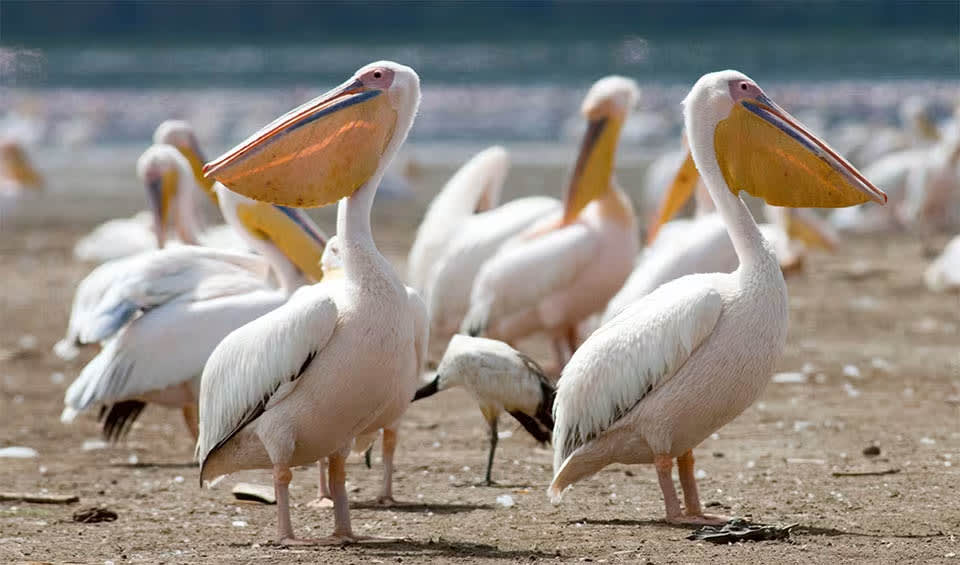Distinguished by its impressive size and striking appearance, this pelican is one of the largest flying birds in the world, boasting a wingspan that can reach up to 4 meters (12 feet). It is predominantly found in the shallow lakes, swamps, and marshes of Europe, Asia, and Africa, favoring locations where waters are rich in fish.
One of the Great White Pelican’s most remarkable features is its enormous bill, which is the longest of any bird in the world. This bill can be up to 46 cm (18 in) long and is equipped with a unique, stretchy throat pouch that the pelican uses to scoop up fish. After catching its prey, the pelican drains the water from its pouch before swallowing the fish whole. During feeding times, these pelicans often work as a team to herd fish into shallow waters, making them easier to catch.
The body of the Great White Pelican is equally impressive. They have a hefty build with predominantly white plumage, which is beautifully contrasted by the pale pink facial skin around their eyes and bill. During the breeding season, adults develop a subtle yellowish hue on their chests and a pinkish blush on their breast feathers, adding to their colorful display. Their legs and webbed feet are usually greyish-blue, adding a final touch to their distinctive appearance.
An interesting aspect of their behavior is their migratory pattern. Some populations of Great White Pelicans are migratory, traveling considerable distances between their breeding and wintering grounds, while others are more sedentary, staying in the same area year-round. Their ability to soar gracefully on thermal air currents during migration is a spectacular sight, with flocks forming impressive formations in the sky.
Distribution
 Afghanistan
Afghanistan Albania
Albania Algeria
Algeria Angola
Angola Armenia
Armenia Austria
Austria Azerbaijan
Azerbaijan Bahrain
Bahrain Bangladesh
Bangladesh Belarus
Belarus Benin
Benin Bosnia And Herz.
Bosnia And Herz. Botswana
Botswana Bulgaria
Bulgaria Burkina Faso
Burkina Faso Burundi
Burundi Cameroon
Cameroon Central Af. Rep.
Central Af. Rep. Chad
Chad Congo-Brazzaville
Congo-Brazzaville Croatia
Croatia Cyprus
Cyprus Czechia
Czechia Côte D’ivoire
Côte D’ivoire DR Congo (Kinshasa)
DR Congo (Kinshasa) Denmark
Denmark Djibouti
Djibouti Egypt
Egypt Eritrea
Eritrea Eswatini
Eswatini Ethiopia
Ethiopia Finland
Finland France
France Gabon
Gabon Gambia
Gambia Georgia
Georgia Ghana
Ghana Greece
Greece Guinea-Bissau
Guinea-Bissau Guinea
Guinea Hungary
Hungary Official estimate
Official estimate
 India
India Iran
Iran Iraq
Iraq Israel
Israel Jordan
Jordan Kazakhstan
Kazakhstan Kenya
Kenya Kuwait
Kuwait Kyrgyzstan
Kyrgyzstan Latvia
Latvia Lebanon
Lebanon Libya
Libya Malawi
Malawi Maldives
Maldives Mali
Mali Malta
Malta Mauritania
Mauritania Montenegro
Montenegro Morocco
Morocco Mozambique
Mozambique Myanmar
Myanmar Namibia
Namibia Netherlands
Netherlands Niger
Niger Nigeria
Nigeria North Macedonia
North Macedonia Norway
Norway Oman
Oman Pakistan
Pakistan Poland
Poland Portugal
Portugal Romania
Romania Russia
Russia Rwanda
Rwanda Saudi Arabia
Saudi Arabia Senegal
Senegal Serbia
Serbia Sierra Leone
Sierra Leone Slovenia
Slovenia Somalia
Somalia South Africa
South Africa South Sudan
South Sudan Spain
Spain Sri Lanka
Sri Lanka Sudan
Sudan Switzerland
Switzerland Syria
Syria Tanzania
Tanzania Togo
Togo Tunisia
Tunisia Turkmenistan
Turkmenistan Turkey
Turkey UAE
UAE Uganda
Uganda Ukraine
Ukraine Uzbekistan
Uzbekistan Yemen
Yemen Zambia
Zambia Zimbabwe
ZimbabweAnything we've missed?
Help us improve this page by suggesting edits. Glory never dies!
Suggest an editGet to know me
Terrestrial / Aquatic
Altricial / Precocial
Polygamous / Monogamous
Dimorphic (size) / Monomorphic
Active: Diurnal / Nocturnal
Social behavior: Solitary / Pack / Flock
Diet: Carnivore / Herbivore / Omnivore / Piscivorous / Insectivore
Migratory: Yes / No
Domesticated: Yes / No
Dangerous: Yes / No




